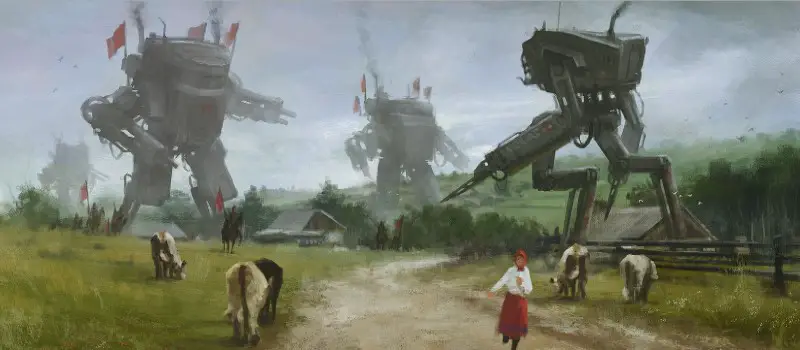
In this variant of Scythe, there is an "all out war" that occurs after the standard game ends, where all sides battle for military domination of Eastern Europa. With the All Out War variant, the game is played in two halves; the first half is the standard game which determines the starting situation of the second half of the game, and the winner of the second half of the game determines the overall victor.
The standard game sets the stage for the all out war that follows, with the 1st, 2nd and 3rd place faction receiving mobilization bonuses.
The idea for the variant is that Scythe seems like you are building up for a final confrontation that never actually happens, as if you are building a war machine for a war that never occurs. This variant allows that war to be fought.
Faction Components

100 divisions. Each 10mm wooden cube is a "division", a generic combat unit of combined arms with a strength of approximately 10,000 soldiers. Divisions only appear in the All Out War stage of Scythe, after the standard game has been resolved.
Divisions are the basic combat unit that the faction is preparing to mobilize in large numbers in the standard game. The supply of cubes represents a finite manpower pool of one million soldiers. Divisions are considered to be combat units and share similar rules pertaining to those types of units. Divisions can engage in combat, can be transported by mechs and airships and they are your mass produced combat unit that will allow you to occupy and dominate large portions of Eastern Europa.
Divisions behave like other units but have a few unique characteristics:
Divisions can move as a group called a "corps" (pronounced as "cores", not "corpse"), which can be any number of divisions in a single territory. A corps is treated as a single unit when moving into another territory, and all divisions in a corps must move together to the same destination. When you are moving a unit, decide how many divisions from the territory will make up the corps by simply grabbing a hand full of wooden blocks, then move them together and drop them into their destination. Divisions moving as a corps count as one move. If you only want to move one division into another territory then this also counts as one move.
Divisions always move one territory at a time unless carried by a mech or airship.
Divisions can never move across lakes or rivers unless carried by a mech or airship. In either case the normal rules for carrying workers apply (they can move one territory and then be carried, or they can be carried and then move one territory).
Like other units, divisions must stop when they enter a territory containing enemy units.
When moving divisions, at least one division must always remain behind if it would be mean that the territory it moved from would be vacant of your own structures or divisions.
Divisions are not characters or mechs, so they cannot utilize character or mech abilities by themselves (such as Riverwalk).
In combat, divisions allow the play of an additional combat card. The presence of at least 5 divisions in combat also provides that faction a free combat card at the start of each combat round (in All Out War, combat can have multiple rounds).
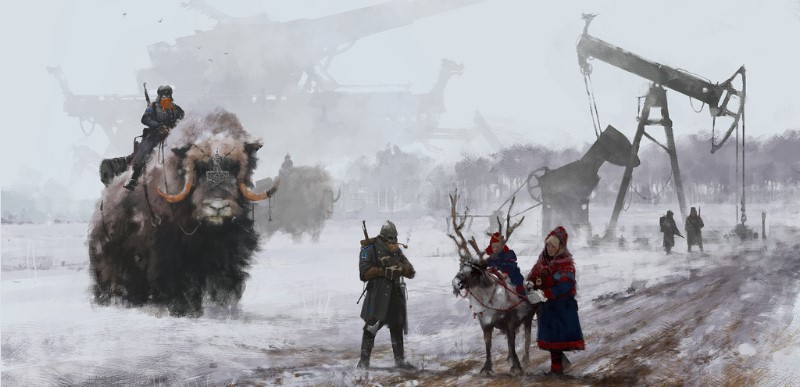
Mobilization Phase (Post Scythe)
Following the end of the standard Scythe game, after the usual winner is determined, do the following in order:
Each faction takes their wooden cubes and counts them, to ensure that everyone has the exact same number of cubes available. These cubes are then placed into a receptacle near their owning faction. These cubes are combat units (divisions), and while they are in the receptacle, they represent a finite pool of un-recruited available manpower (referring to as the Recruitment Pool).
Award the first, second, and third place sides bonus divisions:
first place side receives 15 bonus divisions, placed immediately in near the Faction Mat (in an area that will be referred to as Deployment Pool).
second place side receives 10 bonus divisions, placed immediately in Deployment Pool
third place side receives 5 bonus divisions, placed immediately in Deployment Pool
Award each side additional bonus divisions based on some scoring categories:
highest (or tied with highest) popularity side receives 5 bonus divisions, placed immediately in Deployment Pool
highest (or tied with highest) controlled resource side receives 5 bonus divisions, placed immediately in Deployment Pool
the faction that controlled the Factory receives 5 bonus divisions, placed immediately in the Deployment Pool
each faction receives 3 divisions per recruit tokens it has, placed immediately in Deployment Pool
each faction receives 1 division per territory they control, placed immediately in each controlled territory
If any faction has placed a division in a territory that is adjacent to another faction's Home Base, then that territory must be handed over to the adjacent Home Base's faction. When this occurs, the faction giving up the territory gets to chose the same number of territories from the adjacent Home Base factions holdings to swap with, and the adjacent Home Base faction has no say in the exchange. However the swapped territory cannot be another territory located adjacent to another faction's Home Base.
Remove all resources from the board and return them to the game box.
Remove all workers from the board and return them to the game box.
Remove all popularity markers from the Popularity Track and return them to the game box.
Return all Factory cards to the game box.
Remove all Albion Flag tokens and Togawa Trap tokens from the map.
Move all Characters to their respective Home Base areas; these units will now command the war effort from that location which serves as the faction's HQ.
Move all mechs to their Home Base, as these are placed in the final step of the Mobilization Phase. Leave all unproduced mechs on your Faction Mat.
Move each faction's airship to the Home Base, as these are placed in the final step of the Mobilization Phase.
Starting with the first place faction, each faction takes a turn placing 5 divisions from the Deployment Pool into one or more territories that faction controls. If a faction does not have 5 divisions available to place, then it places any divisions it has remaining, and skips its subsequent deployment turns.
Once all divisions are deployed from each faction's Deployment Pool, then starting with the first place faction one mech is deployed from the Home Base to any territory that faction controls. Each faction deploys one mech into a territory they control until all mechs have been deployed from the Home Base areas.
Once all mechs have been deployed from each faction's Home Base, each faction moves their airship from the Home Base to a territory they control.
Reset the Action Pawn by removing it from the Game Mat, allowing you to place it on any valid action at the start of your turn.
Once all Actions Pawns have been reset, All Out War is now ready to commence.
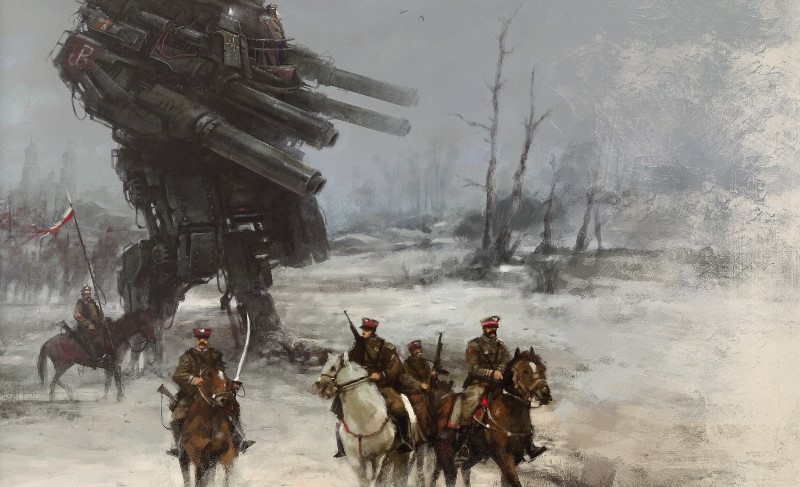
All Out War Phase
Following the Mobilization Phase, beginning with the first place faction and continuing until a winner is determined, an all out war is fought with each faction taking its turn.
In All Out War, coins and power are still used, however resources and popularity are not.
Object of the Game
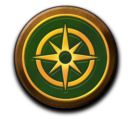
In All Out War, each faction's goal is to control 25 points worth of territorial control at the end of their action turn.
Territorial points are determined as follows:
the factory is worth 3 territorial points.
villages are worth 2 territorial points each.
every other non-lake territory is worth 1 territorial point each. Once any faction has achieved 25 territorial points of control at the end of their turn then that faction is declared the ultimate winner of the game.
Optionally, the winner of the standard pre-All Out War game can also be considered as a co-winner, with the overall goal being to win both the standard and All Out War segments for a complete, rather than partial, victory.
During the course of All Out War, a faction may be forced to capitulate, awarding a large amount of booty to its conqueror.
A faction capitulates when, at any moment, an opposing faction occupies and controls a non-lake territory adjacent to its Home Base.
When a faction capitulates, all of the following occurs:
the capitulated faction removes its Character, mechs and airship from the board.
all of the capitulated faction's coins, power, and combat cards are given to the conquering faction.
the conquering faction gains ownership of all of the capitulated factions divisions deployed on the game board (but not the capitulated faction's Recruitment Pool); these deployed divisions are considered to be owned by the conquering faction in every way, as if they were of that faction's color.
Note: If a faction's Home Base is very close to another faction's Home Base, then both factions are encouraged to negotiate a border truce along certain territories.
Game Turn
On a faction's action turn, a player chooses to take a top row action of either a bolster action (purchase power or combat cards), a move action (move combat units and fight), or a produce action (purchase and deploy new divisions). The trade and factory actions are not used in All Out War, nor are any of the bottom row actions.
The rationale for this is because now it is a time for all out war, resources have been gathered, and forces are mobilized. War is now the emphasis. Think of this as an economy mobilizing completely for war with what it had amassed before hostilities began.
The normal restriction about not being able to take the same action twice in a row still applies in All Out War.
On a faction's action turn, it may conduct a:
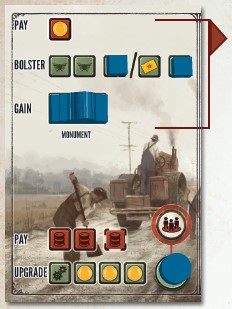
Bolster Action
The bolster action functions in the same way as it does in the standard game, except that when choosing to gain power, you gain 2x the power you would normally receive.

Move Action
The move action functions in the same way as it does in the standard game, with the following additions:
Divisions can move as a group called a "corps" which can be a collection of any number of divisions in a single territory. A corps is treated as a single unit when moving into another territory and all divisions in a corps must move together to the same location. When you are moving a corps as a unit, decide how many divisions from the territory will make up the corps by simply grabbing a hand full of them, then move them together and drop them into their destination (the player doesn't need to say anything when doing this).
Divisions moving as a corps count as one move. If you only want to move one division into a different territory then this also counts as one move. In other words, a single move is made up of any number of divisions from one territory moving into one adjacent territory.
Divisions move one territory at a time unless carried by a mech or airship. When divisions are carried by a mech or airship, they can move and then be carried, or can be carried and then move, however if carried divisions are unloaded in an enemy held territory then they must stop (they cannot be unloaded into an enemy held territory and then move).
Airships can carry up to 10 divisions.
Mechs can carry up to 5 divisions but the divisions are considered to be dropped off into the territory the mech occupies at the end of its movement. If a mech carrying divisions moves into an enemy occupied territory then, as in the standard rules, the mech and divisions must end their movement (the divisions are dropped off into that territory).
Divisions can never move across lakes or rivers unless carried by a mech or airship. In either case the normal rules for carried pieces apply (they can move and then be carried, or carried and then moved).
When moving divisions, at least one division must always remain behind if it would be mean that the territory it moved from would be vacant of your own structures or divisions.
Divisions are not characters or mechs, so they cannot utilize character or mech abilities by themselves (such as Riverwalk).
Once all movement is complete, if divisions are located in a territory that contains an enemy structure with no enemy units, that enemy structure is destroyed and placed into a casualty pile. Destroyed structures no longer provide any benefit to its owner (i.e. a destroyed mine no longer acts as a tunnel for that faction).

Produce Action
In All Out War, the produce action only produces new divisions. Ignore all symbols for the produce action on the Game Mat, and instead treat it as if it only has the following:
- pay [10 coins]
- gain [5 divisions]
A single produce action spends 10 coins to purchase 5 divisions, if those divisions are available in the recruitment pool. If less than 5 divisions are available to recruit, then the action will recruit all remaining divisions. When deploying newly purchased divisions, divisions can be placed in or spread across any territories that you control.
Count Territorial Points
At the end of a faction's action turn, that faction's territorial points are quickly counted up and announced to all other players. If the faction has achieved 25 or more territorial points, then it is immediately declared as the winner.
At any point if all factions agree that no one faction can achieve 25 territorial points then the war ends in a stalemate, a draw/tie for all sides.
It is suggested to appoint a player as the points keeper who has a scratch sheet of paper with each player's total territorial points listed. When a territory is gained or lost, then the points keeper can easily adjust the ownership totals. Occasional spot checks should still be done as requested by other players.

Combat
In All Out War, combat can occur over multiple rounds until the attacker decides to retreat. Also, all destroyed units are permanent.
Losses in divisions and structures are placed into a designated "casualty area" on the table to keep track of the cost of war for the achievement sheet, and to ensure that they are not used again.
Destroyed mechs and airships are collected and claimed as trophies by the faction that destroyed them.
Divisions
Divisions are used to establish control across the territories of Eastern Europa. Divisions also soak up hits in combat in a war of attrition, and in large enough numbers provide perpetual combat power in battle.
At the start of every combat round including the first, each side that has at least 5 divisions remaining in combat draws a combat card.
When fighting over a lake territory, for simplicity divisions carried by mechs participate in the combat as normal.
Mechs
Any combat result between mechs that causes the other mech to retreat to its Home Base instead causes that mech to be permanently destroyed.
Destroyed mechs are not returned to the Faction Mat and are instead given to the faction that destroyed them to be displayed as war trophies (destroyed mechs are counted in the post game achievements). All of a factions unlocked mech abilities continue to be available even after a mech is destroyed in combat.
Airships
In All Out War, airships can bombard enemy divisions, blitz drop friendly divisions into enemy territory (initiating combat at the end of the action-turn), and can conduct ship-to-ship combat.
Bombard: At the end of a move action, if your airship was activated to move (it doesn't have to actually move though) and is located in a territory occupied by enemy divisions then you may spend 5 power to destroy 1 enemy division, to a maximum of 3 in a single turn. However, the last enemy division in a territory cannot be destroyed by a bombardment.
Blitz drop: At the end of a move action, if your airship was activated to move (it doesn't have to actually move though) and is carrying divisions, you may drop off some or all divisions carried by the airship to initiate an attack. Optionally, the airship may also bombard to soften up the enemy before doing this action.
Ship combat: At the end of a move action, if your airship occupies the same territory as an enemy airship then you can conduct ship-to-ship combat using the standard mech versus mech combat rules. No other forces may participate in ship-to-ship combat.
The losing side of the ship-to-ship combat has its airship returned to its Home Base.
If the loser lost the combat by 5 or more power, then the loser's ship is permanently destroyed.
In either case, if the loser's ship was carrying divisions then all carried divisions are destroyed.
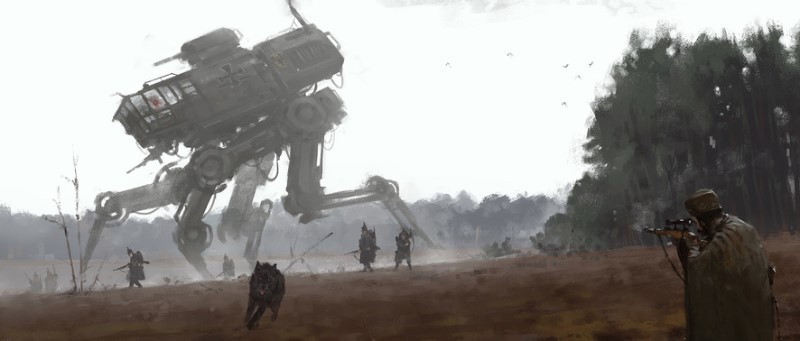
Combat Rule Alterations
In All Out War, combat resolution remains mostly unchanged in regards to power and combat cards. However, combat in a territory can now span multiple combat rounds, where each combat round of a single combat is completed and the combat over the territory entirely resolved before moving onto the next combat.
Combat rounds: In All Out War, the winner of the combat is not determined by one round of combat, instead combat in a territory continues until either one side is destroyed or the attacker decides to retreat to the territory they came from.
Defender advantage: When attacking force does not contain any mechs, the defender wins all ties in combat results.
Note that if the attacker has a mech participating in combat, then the attacker wins ties as normal.
Attrition: After every combat round, the side that lost the round loses 1 division. Also, regardless of which side won the round, the attacking side loses 1 division.
Combat cards (for divisions): In All Out War, when combat is initiated the power dial and combat cards are used as normal. However, an extra combat card may be tucked behind the Power Dial for the faction that has any number of divisions remaining in the combat round.
Also, at the start of each combat round (including the first), each side that has at least 5 divisions remaining in combat draws one combat card.
Just like in the standard rules, at the end of each combat round the losing side gains a combat card if that side used at least one combat card or spent one power on the Power Dial in that combat round.
Reveal: In All Out War, in the reveal step of combat the winner does not immediately gain control of the territory, driving out enemy forces. Instead, the territory is not gained unless the defender is completely destroyed after one or more rounds of combat, and the actual result of each combat round depends on the composition of forces.
Divisions in combat: If one or both sides have divisions (with or without mechs) remaining in combat, then the side that lost the combat round loses a number of divisions in that territory equal to the difference of the two side's power total, +1 division lost for the side that lost the round, and +1 division lost for the attacker due to attrition.
Mechs in combat: Mechs are never taken as a division loss casualty, instead they remain in combat until there are no divisions remaining and are only destroyed if they lose a combat round in which there were no friendly divisions remaining at the start of that round. Only one mech can be destroyed in each combat round.
In combat, an attacking or defending force is considered to be "destroyed" when:
a side has no mechs participating in combat and takes its last division as a casualty (regardless of whether that side won or lost the current combat round).
a side has lost a combat round in which it only had one mech remaining at the start of the combat round. Winner: The winner of the combat gains (or maintains) control of the territory, but no stars are gained as they are no longer used in All Out War.
Loser: Similar to the standard game, if the loser used at least one power in the combat round then the loser draws a combat card (this happens after each combat round).
Trophies: When mechs or airships are destroyed, the faction that destroyed them takes them as trophies for achievement purposes.
Complete Destruction: If both sides are destroyed in the final combat round, then neither side is considered to have won or lost the battle. Instead the territory being fought over is left empty, and can be captured by any side moving into it on their turn. This is the only way in which a territory can be left vacated of divisions.
Attacker Retreats: If the attacker decides to retreat, then the combat ends with the attacking force retreating back to the territory they came from and the combat ends (until the battle is resolved, the attacking force should remain in separate groups on the board if they advanced from different territories).
Continue Reading

